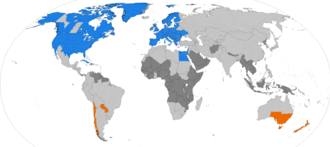The newest registered user is гераскинс
Our users have posted a total of 48009 messages in 7050 subjects

WORLD CLOCK
DAYLIGHT SAVING(s) TIME IN ARIZONA
Valley of the Sun Casual Club :: Current Events ,,Announcements , Bulletin Board , 2 Pages :: ARIZONA
 DAYLIGHT SAVING(s) TIME IN ARIZONA
DAYLIGHT SAVING(s) TIME IN ARIZONA
Arizona is on Mountain Standard Time (link is external). Arizona does not observe Daylight Saving Time, with the exception of the Navajo Nation. Arizona previously observed Daylight Saving Time beginning in 1918, but made the permanent change to Standard time in 1968.
Time zones in the United States developed in the mid-nineteenth century to accommodate railroad schedules, which required standardizing time across the nation. Before the adoption of time zones, local communities each observed their own time schedules.
OR
Time in Arizona, as in all U.S. states, is regulated by the United States Department of Transportation[1] as well as by state and tribal law.
All of Arizona is in the Mountain Time Zone.[2] Since 1968, most of the state—with exceptions noted below—does not observe daylight saving time and remains on Mountain Standard Time (MST) all year. This results in most of Arizona having the same time as neighboring California each year from March to November, when locations in the Pacific Time Zone observe daylight saving time.
Daylight saving time

Daylight saving time (DST) observance across Arizona. Green regions observe DST, grey do not.
Unlike most of the United States, Arizona does not observe daylight saving time (DST), with the exception of the Navajo Nation, which does observe DST. The Hopi Reservation, which is not part of the Navajo Nation but is geographically surrounded by it, also does not observe DST.[2] For this reason, driving the length of Arizona State Route 264 east from Tuba City while DST is in place involves six time zone changes in less than 100 miles (160 km).
Reasoning
Because of Arizona's hot climate, DST is largely considered unnecessary. The argument against extending the daylight hours into the evening is that people prefer to do their activities in the cooler morning temperatures. The Navajo Nation, a semi-autonomous Native American territory, follows the United States DST schedule. It lies in northeastern Arizona, northwestern New Mexico, and southeastern Utah and thus maintains the same time throughout tribal lands despite state borders.[3]Legislative history
On March 21, 1968, the Arizona legislature passed the final version of SB 1, placing Arizona under standard time.[4]: 629 [5] The bill had been working its way through the legislature since January of that year, and was sponsored by state Senators Tenney, Goetze, Porter, Halacy, Garfield, Campbell, Lewis, Gregovich, Giss, Crowley, and Holsclaw. It passed the Senate 25–3–2, and afterwards the bill was passed by the House 49–1–10. It was approved by Governor Jack Williams the same day.[5]What wikopedia says about DST origin .
The idea of aligning waking hours to daylight hours to conserve candles was first proposed in 1784 by U.S. polymath Benjamin Franklin. In a satirical letter to the editor of The Journal of Paris, Franklin suggested that waking up earlier in the summer would economize on candle usage; and calculated considerable savings.[1][2] In 1895, New Zealand entomologist and astronomer George Hudson proposed the idea of changing clocks by two hours every spring to the Wellington Philosophical Society.[3] In 1907, British resident William Willett presented the idea as a way to save energy. After some serious consideration, it was not implemented.[4]
Daylight saving time wikopedia
From Wikipedia, the free encyclopedia
"DST" redirects here. For other uses, see DST (disambiguation).

Daylight saving time regions:
Northern Hemisphere summer
Southern Hemisphere summer
Formerly used daylight saving
Never used daylight saving
Daylight saving time (DST), also referred to as daylight savings time or daylight time (United States, Canada, and Australia), or summer time (United Kingdom, European Union, and others), is the practice of advancing clocks (typically by one hour) during warmer months so that darkness falls at a later clock time. The typical implementation of DST is to set clocks forward by one hour in either the late winter or spring ("spring forward"), and to set clocks back by one hour in the fall ("fall back") to return to standard time. As a result, there is one 23-hour day in early spring and one 25-hour day in the middle of autumn.
The idea of aligning waking hours to daylight hours to conserve candles was first proposed in 1784 by U.S. polymath Benjamin Franklin. In a satirical letter to the editor of The Journal of Paris, Franklin suggested that waking up earlier in the summer would economize on candle usage; and calculated considerable savings.[1][2] In 1895, New Zealand entomologist and astronomer George Hudson proposed the idea of changing clocks by two hours every spring to the Wellington Philosophical Society.[3] In 1907, British resident William Willett presented the idea as a way to save energy. After some serious consideration, it was not implemented.[4]
In 1908, Port Arthur in Ontario, Canada, now merged into Thunder Bay, started using DST.[5][6] Starting on 30 April 1916, the German Empire and Austria-Hungary each organized the first nationwide implementation in their jurisdictions. Many countries have used DST at various times since then, particularly since the 1970s energy crisis. DST is generally not observed near the Equator, where sunrise and sunset times do not vary enough to justify it. Some countries observe it only in some regions: for example, parts of Australia observe it, while other parts do not. Conversely, it is not observed at some places at high latitudes, because there are wide variations in sunrise and sunset times and a one-hour shift would relatively not make much difference. The United States observes it, except for the states of Hawaii and Arizona (within the latter, however, the Navajo Nation does observe it, conforming to federal practice).[7] A minority of the world's population uses DST; Asia, Africa, and Latin America and the Caribbean generally do not.
https://en.wikipedia.org/wiki/Daylight_saving_time
 Similar topics
Similar topics» GOOD TIMES ROCK CONCERTS IN TEMPE
» Arizona State Capitol 4K Walking Tour - Phoenix Arizona
» WONDER IF THIS GUY REMEMBERED TO PLAY A ROUND EVER
» TIME MAGAZINE ......
Valley of the Sun Casual Club :: Current Events ,,Announcements , Bulletin Board , 2 Pages :: ARIZONA

 Events
Events















































































» INTRO TO WORD SMARTS
» PINTEREST ICONIC COMIX
» HISTORY FACTS * Gold wasn't always the top Olympic medal *
» Word Genius Word of the day * occlude *
» JULY NATIONAL CELEBRATION DAYS JULY 26 2024
» QUIZ TREAT QUIZ *Which mammal has the most powerful bite? *
» QUIZ TREAT ANSWER PAGE
» NAT GEO * The 2024 Olympics will likely be the hottest ever *
» NAT GEO * Sharks found with cocaine in their systems *
» WISE TRIVIA QUIZ *What was the first song ever played on the radio? *
» WISE TRIVIA ANSWER PAGE
» E.S.Etaski * Sister Seekers Book 10 now available everywhere! *
» WORD DAILY Word of the Day: * literatim *
» JULY NATIONAL CELEBRATION DAYS JULY 25 2024